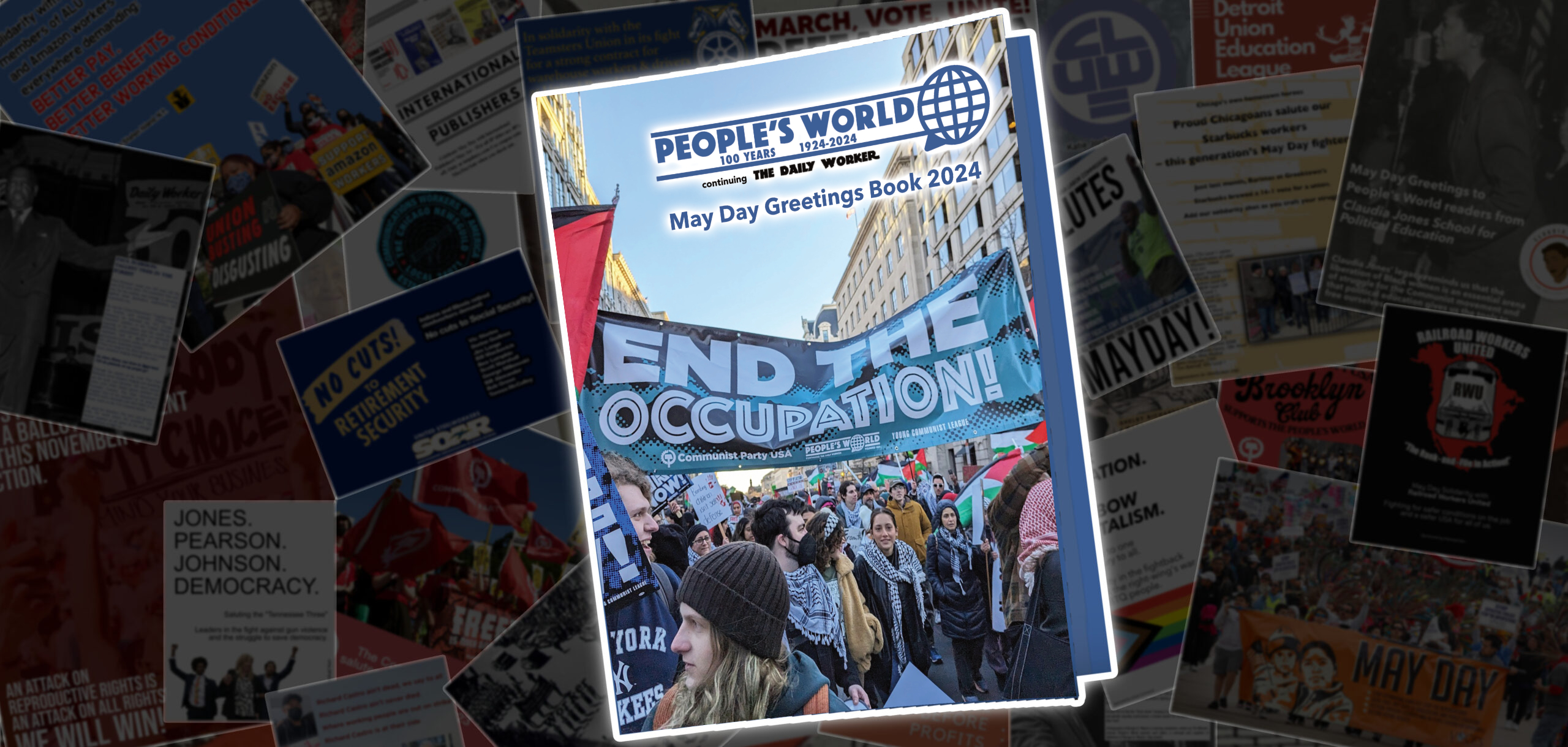
On May 1st, 1924, the Daily Worker was just 11 weeks’ old. Around the United States, workers in many big cities had not even heard of it yet. But if that inaugural May Day edition of the paper happened to be the first issue put into their hands, a survey of headlines and stories on the front page told them everything they needed to know about the Daily Worker and where it stood:
“100,000 quit Chicago jobs”
“Pennsylvania miners abandon pits”
“Striking Detroit workers donate day’s wages to Daily Worker”
“Demonstrations forbidden in the American sugar trusts’ Cuban colony”
“Eight killed in Germany by police at rallies”
“10,000 march in Tokyo”
“Taxi, bus, and subway workers paralyze Paris”
“Workers take over Moscow streets in massive Soviet parade”
This was a newspaper that clearly took sides. Wherever people were in struggle, whether in the United States or elsewhere in the world, the Daily Worker shared the news of their fights against the bosses and celebrated labor’s victories.
Born in the U.S.A.
Like May Day itself, the Daily Worker was born right here in the U.S.A. In fact, they come from the same Chicago neighborhood. At the Haymarket Massacre of 1886, police attacked workers striking to demand the 8-hour workday—giving the world International Workers Day. Haymarket Square is only a few blocks south of where a North Halsted Street printing plant produced the first issue of the Daily Worker in 1924.
And just like May Day, the Daily Worker was a challenge to the ruling class of this country. It was proof that the millions of people who make up the majority wouldn’t be silent in the face of their oppression.
The Communist journalists of a century ago dedicated themselves to indicting capitalism every day, along with the racism, sexism, nationalism, and profiteering at its core. They knew that the monopoly the bosses had over information was a key weapon used to control and divide the working class.
They wanted to break that monopoly and finally give workers a media outlet that spoke for them—and just as importantly, let them speak for themselves. They firmly believed that the people of this country should be the authors of their own future.
They were confident that when workers got organized politically as a class, they would democratize not just how this land was governed but how its economy functioned. The founders of the Daily Worker knew that eventually the people of the U.S. would choose to leave the capitalist class behind and chart a path toward a socialist system.
But to win that future, the working class required a party of its own, and a newspaper was exactly the tool around which such a party could be organized.
The cost of telling the people’s stories
Establishing the Daily Worker was a gigantic undertaking. Never before had there been a national labor paper that covered strikes and struggles from coast-to-coast. A network of correspondents had to be built up, and the founding leaders of the paper scoured for reporters in every major city of the country.
Founding a workers’ paper was not a cheap task, either. A printing press had to be found, offices rented, editors and writers recruited, paper purchased, distributors hired, and postage paid—sometimes in advance.
Hundreds of thousands of dollars were raised in the months leading up to the newspaper’s launch. Spearheading the campaign was the Communist Party, backed by a coalition of trade unions, socialist groups, fraternal immigrants’ organizations, and others.
One of the ways that unions, cooperatives, and groups showed their support for the Daily Worker was to buy ad space in its pages.
In those early issues, scattered throughout the paper were things like strike solidarity messages, favorable mortgage rates for workers and their families from credit unions, advertisements for the daily lunch specials at worker-owned cafeterias, and coupons for discount travel from agencies specializing in tours of revolutionary Russia.
Communist clubs promoted their balls and bazaars. The party press hawked Marxist books and pamphlets on socialism. There were even a few confused capitalists who hadn’t gotten the memo about what kind of paper the Daily Worker was and sent in ads for their products, too. The publishers cashed their checks and put the money to work for the working class.
Thank you
Today, a hundred years later, People’s World—the successor to the Daily Worker—carries on that same tradition of partisan, worker-supported journalism.
But just like time itself, our publication hasn’t stood still. It has grown and broadened its perspectives, enriched by decades of reporting on and participating in the mass movements for social, political, and economic change in the United States.
It is a tribune for workers and all oppressed people in our country; a platform for the democratic movements fighting to save democracy from fascism; a determined opponent of sexism, racism, and anti-LGBTQ hate; and a voice demanding a ceasefire and an end to the genocide and occupation in Palestine. Encompassing all these things and more, it is a voice for socialism.
The 2024 May Day Greetings Book you are looking at on your screen is in many ways a digital-era revival of those classifieds and ad pages of old.
People’s World may not come out in print every day anymore, but this book is a way to open our “pages” to the paper’s supporters and friends, allowing them a chance to financially support PW while also getting their own message out to the thousands of people who read us.
This is the second annual edition of the book, and it’s already become a big component of the Spring Fund Drive. Many groups and individuals are making a second appearance this year, with fresh messages or remembrances. Other contributors are here for the first time.
Flip through these pages, and you’ll get a sampling of the breadth and depth of the issues that matter most to the readers of People’s World.
Then, join the movement of People’s World sustainers if you’re not one already. Written articles, photographic and video contributions, online and print distributions, using PW to organize in workplaces, commenting on articles, starting or participating in reader discussion groups, raising money—there are so many ways to get involved.
How will you help out?
Finally, to all the readers and supporters of People’s World, the editorial, reporting, and production staff say thank you. Maybe you have been with us for decades or perhaps this ad booklet is the first time you’ve heard of us. Either way, we’re happy you’re here, and we appreciate you.
Happy May Day!
C.J. Atkins
Managing Editor










